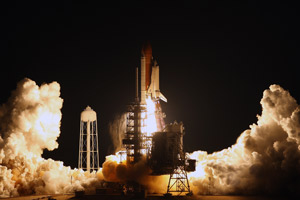Focus on America
Spectacular Night Launch Sends Japan, Canada Devices to Station

Two launches within three days are sending equipment and astronauts to the International Space Station (ISS), which will represent for the first time the interests of all five space station partners -- the United States, Japan, Canada, Russia and the European Space Agency (ESA).
Space shuttle Endeavour’s spectacular night launch from the Kennedy Space Center lit up the east coast of Florida in the pre-dawn hours of March 11, on a mission that includes delivery of the first pressurized component of the Japanese Kibo laboratory, a two-armed Canadian robotic device called Dextre and five spacewalks. Endeavour’s 16-day flight is the longest shuttle mission so far to the space station.
“God has truly blessed us with a beautiful night to launch,” Endeavour Commander Dominic Gorie said just before launch, “so let’s light it up and give them a show.”
On the morning of March 9, Jules Verne, the first of the ESA’s automated transfer vehicles (ATVs), a new series of autonomous (unmanned) spaceships designed to resupply the space station and adjust its attitude (reboost) to compensate for orbit decay, launched from the Guiana Space Centre at Europe’s spaceport into low Earth orbit on a modified Ariane 5 rocket.
Over the next few weeks, the ESA spacecraft will maneuver to rendezvous and eventually dock with the space station to deliver cargo, propellant, water and oxygen to the orbital outpost.
At a post-launch press briefing, Keiji Tachikawa, president of the Japan Aerospace Exploration Agency (JAXA), and Canadian Space Agency director Guy Bujold expressed their gratitude to NASA and the other space station partners and their hope about their future in space.
“With this flight,” Tachikawa said, “I believe we fully became a real partner in the International Space Station project."
JULES VERNE
The new spacecraft, circling Earth in the same orbital plane as the space station but at an altitude of 260 kilometers rather than the station’s 345 kilometers, will undergo tests in this orbit for two weeks before it catches up with and docks to the space station.
On the grounds of the French space agency, the Centre National dEtudes Spatiales, the ATV Control Center will ensure flight control during the mission in coordination with the space station mission control centers in Moscow and Houston. The spacecraft will rendezvous with the space station April 3 after Endeavour undocks to return to Earth.
“Last month, with the docking of Columbus, Europe got its own flat in the ISS building,” said Daniel Sacotte, ESA director for human spaceflight, microgravity and exploration, in a statement. “With the launch of the first ATV, we now have our own delivery truck. We have become co-owners of the ISS, and now we are about to become fully fledged partners in running it.”
Named after the French 19th-century visionary and author, the Jules Verne ATV is the largest and most sophisticated spacecraft ever developed in Europe, combining the functions of an unmanned free-flying platform, a maneuverable space vehicle and a space station module.
The spacecraft includes a 45-square-meter pressurized module and a Russian-built docking system like those used on the Soyuz manned ferries and the Progress resupply ship. Jules Verne is about three times larger than the Russian Progress and can deliver three times more cargo.
The ATV is the first spacecraft designed to conduct automated docking in full compliance with tight safety constraints imposed for human spaceflight operations.
On its first mission, Jules Verne will deliver 4.6 metric tons of payload to the space station, about half of which is reboost propellant, which its own propulsion system will use for periodic maneuvers to increase the space station’s altitude, compensating for the natural decay of its orbit caused by atmospheric drag.
Jules Verne will stay at the station for four months and will carry away waste when it undocks. It then will be guided out of orbit over the southern Pacific Ocean and burn up in the atmosphere.
ESA has contracted with industry to produce four more ATVs to be flown through 2015.
ENDEAVOUR
During the 16-day flight, Endeavours seven astronauts will work with the three-member space station crew and ground teams around the world to install the first section of the JAXAs Kibo laboratory and the Canadian Space Agencys two-armed robotic system, known as Dextre. (See “Equipment from Japan, Canada To Launch with Shuttle on March 11.”)
Commander Gorie, 50, is a veteran of three spaceflights and a retired U.S. Navy captain. The spacecraft’s pilot is Gregory Johnson, 45, a U.S. Air Force colonel. STS-123 mission specialists are Robert Behnken, 37, a U.S. Air Force major; U.S. Navy Captain Mike Foreman, 50; Japanese astronaut Takao Doi, 53; Rick Linnehan, 50, a veteran of three shuttle flights; and Garrett Reisman, 40.
Reisman will stay aboard the station with commander Peggy Whitson and fellow flight engineer Yuri Malenchenko. He will replace Léopold Eyharts, a French Air Force general and ESA astronaut who will return to Earth on Endeavour. Eyharts launched to the station aboard Atlantis on STS-122 in February.
Recently on Focus on America
Shuttle Launches To Deliver European Space Agency Lab to Station
 With the February 7 afternoon launch of Atlantis through cloud-swept skies above Kennedy Space Center in Florida, the European Space Agency’s (ESA) most important contribution to the International Space Station -- its Columbus laboratory – is finally on its way to the orbital outpost.
With the February 7 afternoon launch of Atlantis through cloud-swept skies above Kennedy Space Center in Florida, the European Space Agency’s (ESA) most important contribution to the International Space Station -- its Columbus laboratory – is finally on its way to the orbital outpost.
Athletics, Politics Offer Shared Lessons on Life
 Competition and leadership are among the common threads tying great athletes to successful second careers in politics, several former U.S. standout athletes tell America.gov.
Competition and leadership are among the common threads tying great athletes to successful second careers in politics, several former U.S. standout athletes tell America.gov.
U.S. Politics, Literature, Sports Show Influence of Hispanics
 The influence of Latinos, especially as the U.S. population grows, is felt in every aspect of society, but especially in baseball, politics and literature, says Pilar O’Leary of the Smithsonian Institution.
The influence of Latinos, especially as the U.S. population grows, is felt in every aspect of society, but especially in baseball, politics and literature, says Pilar O’Leary of the Smithsonian Institution.